| Administrative districts Управни окрузи Upravni okruzi | |
|---|---|
 | |
| Category | Unitary state |
| Location | Serbia |
| Created |
|
| Number | 24 (29 includingKosovo) |
| Populations | 77,341 (Toplica) – 607,178 (South Bačka) |
| Areas | 1,248 km2 (482 sq mi) (Podunavlje) – 6,140 km2 (2,370 sq mi) (Zlatibor) |
 |
|---|
|
|
 Serbia portal Serbia portal |
Theadministrative districts (Serbian:управни окрузи,romanized: upravni okruzi) ofSerbia aredeconcentrated coordination units of the central government, established under the 2005 Law on State Administration and implemented through government decrees. They are notadministrative divisions, as theadministrative divisions of Serbia are constitutionally defined units ofself-governance or autonomy, but rather regional operational centers serving ministerial field offices (such as branches of inspection authorities). Each has a territorial remit matching a certain cluster ofmunicipalities and cities (which are constitutionally and statutorily defined administrative divisions).
Originally instituted by a 1992 government decree, there are 29 administrative districts, with the City of Belgrade having similar status.[1] Following the2008 Kosovo declaration of independence, thedistricts created by the UNMIK-Administration were adopted byKosovo. The Serbian government does not recognize these districts.
Territorially, an administrative district is merely a designation of the territorial remit of a given regional centre of state administration, through which the central government exercises its power within a hierarchical structure. In practical and organizational terms, administrative districts are often small field offices coordinating deconcentrated state functions with no independent decision-making authority. Each is headed by a government-appointed functionary-level official titled Head of the Administrative District.
The administrative districts are generally named after historical and geographical regions, though some, such as thePčinja District and theNišava District, are named after local rivers. Their areas and populations vary, ranging from the relatively-smallPodunavlje District to the much largerZlatibor District. The termokrug (pl.okruzi) means "circuit" and corresponds (in literal meaning) tobezirk in the German language. Prior to a 2006 decree, the administrative districts were named simplydistricts.
Administrative districts were first defined by the decree of theGovernment of Serbia on 29 January 1992, which specified that ministries and other national-level agencies shall conduct their affairs outside their headquarters (i.e. outside theseat of government) via regional offices that they may establish per the designated clusters of municipalities (named only "districts"), also designating the administrative seat of each district ("regional centre of state administration").[2] The 2005 Law on Public Administration provided a legal definition of a district, under the term "administrative district".[3]
An administrative district shall be established for the execution of state administration tasks outsidethe headquarters of the state administration authority.
...
The Government shall establish administrative districts by its regulation, by which it shall also determine areas and seats of administrative districts.
In 2006, the Government enacted the Decree on Administrative Districts, which renamed the districts intoadministrative districts.[4]
The territorial organisation of Serbia is regulated by the Law on Territorial Organisation, adopted by theNational Assembly on 29 December 2007. According to the Law, the territorial organisation of Serbia comprises municipalities and cities, the City of Belgrade with special status, and autonomous provinces.[5][6]Not subject to this law, or even mentioned in it, administrative districts are not territorial organization units. Serbia's territory is not politically subdivided into them, and rather than being further divisible into municipalities, each overlaps with its corresponding cluster of municipalities. As such, administrative districts are not articulations oflocal governance orautonomy and are purely a mechanism ofdeconcentration (the weakest form of decentralization), remaining dependent on the central executive branch.[6][7]
As extensions of the central government that lack standalone institutional personality, administrative districts do not possess flags or coats of arms distinct from thenational symbols of Serbia.[8]
Under the Law on Public Administration, administrative districts are formed by the Government by its Decree on Administrative Districts, which also determines the territory and head office of each administrative district. There are 29 administrative districts in the Republic of Serbia.[9]
| District | Seat | Area in km2 | Population | Population per km2 | Municipalities and cities | Settlements |
|---|---|---|---|---|---|---|
| Bor District (Borski okrug)  | Bor | 3,507 | 101,100 | 28.8 | 90 | |
| Braničevo District (Braničevski okrug)  | Požarevac | 3,865 | 156,367 | 40.5 | 189 | |
| Central Banat District (Srednjobanatski okrug)  | Zrenjanin | 3,256 | 157,711 | 48.4 | 55 | |
| Jablanica District (Jablanički okrug)  | Leskovac | 2,769 | 184,502 | 66.6 | 336 | |
| Kolubara District (Kolubarski okrug)  | Valjevo | 2,474 | 154,497 | 62.4 | 218 | |
| Mačva District (Mačvanski okrug) 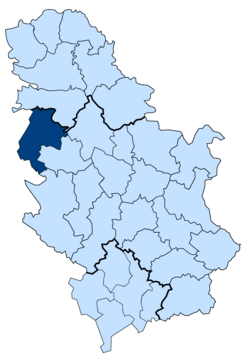 | Šabac | 3,268 | 265,377 | 81.2 | 228 | |
| Moravica District (Moravički okrug)  | Čačak | 3,016 | 189,281 | 62.8 | 206 | |
| Nišava District (Nišavski okrug) 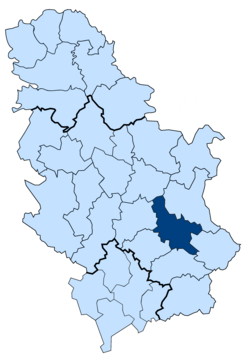 | Niš | 2,729 | 343,950 | 126.0 | 285 | |
| North Bačka District (Severnobački okrug)  | Subotica | 1,784 | 160,163 | 89.8 | 45 | |
| North Banat District (Severnobanatski okrug)  | Kikinda | 2,329 | 117,896 | 50.6 | 50 | |
| Pčinja District (Pčinjski okrug)  | Vranje | 3,520 | 193,802 | 55.1 | 363 | |
| Pirot District (Pirotski okrug)  | Pirot | 2,761 | 76,700 | 27.8 | 214 | |
| Podunavlje District (Podunavski okrug)  | Smederevo | 1,248 | 175,573 | 140.7 | 58 | |
| Pomoravlje District (Pomoravski okrug) 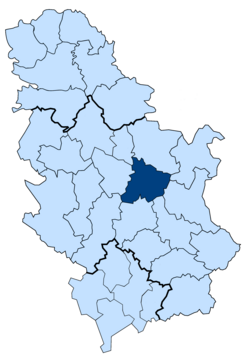 | Jagodina | 2,614 | 182,047 | 69.6 | 191 | |
| Rasina District (Rasinski okrug)  | Kruševac | 2,667 | 207,197 | 77.7 | 296 | |
| Raška District (Raški okrug)  | Kraljevo | 3,918 | 296,532 | 75.7 | 359 | |
| South Bačka District (Južnobački okrug)  | Novi Sad | 4,016 | 607,178 | 151.2 | 77 | |
| South Banat District (Južnobanatski okrug)  | Pančevo | 4,245 | 260,244 | 61.3 | 94 | |
| Srem District (Sremski okrug) 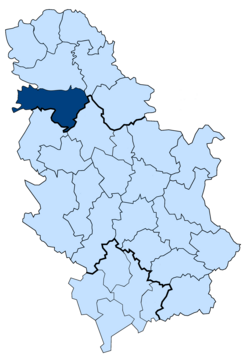 | Sremska Mitrovica | 3,486 | 282,547 | 81.1 | 109 | |
| Šumadija District (Šumadijski okrug)  | Kragujevac | 2,387 | 269,728 | 113.0 | 174 | |
| Toplica District (Toplički okrug)  | Prokuplje | 2,231 | 77,341 | 34.7 | 267 | |
| West Bačka District (Zapadnobački okrug) 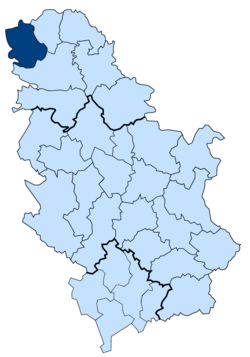 | Sombor | 2,420 | 154,491 | 63.8 | 37 | |
| Zaječar District (Zaječarski okrug)  | Zaječar | 3,623 | 96,715 | 26.7 | 173 | |
| Zlatibor District (Zlatiborski okrug)  | Užice | 6,140 | 254,659 | 41.5 | 438 | |
| Kosovo District[a] (Kosovski okrug)  | Priština | 3,310 | 570,835 | 172.5 | ||
| Kosovo-Pomoravlje District[a] (Kosovsko-pomoravski okrug)  | Gnjilane | 1,389 | 184,864 | 133.1 | ||
| Kosovska Mitrovica District[a] (Kosovsko-mitrovački okrug)  | Kosovska Mitrovica | 2,053 | 234,262 | 114.1 | ||
| Peć District[a] (Pećki okrug)  | Peć | 2,459 | 351,680 | 143.2 | ||
| Prizren District[a] (Prizrenski okrug)  | Prizren | 2,196 | 319,330 | 145.4 |
Okruzi nemaju elemente samouprave niti autonomije, oni su područni centri državne uprave koji obuhvataju okružne područne jedinice svih organa državne uprave koje su obrazovane za njihovo područje. Upravni okruzi imaju načelnika, koji za svoj rad odgovara ministru nadležnom za poslove uprave i vladi.[Districts lack any elements of self-governance or autonomy. They function as regional administrative centres encompassing all of the public administration bodies' field offices that have been established within their territorial remit. Each administrative district is headed by a Head of the Administrative District, who reports directly to the Minister of Public Administration and the national government.]
By nature administrative districts are a form of "pure deconcentration," and their significance primarily stems from the importance of the local units of state administration. Although the role of these local units is defined by the Law on State Administration (2005) with the possibility of expansion it is essential to bear in mind that the administrative district does not represent a separate level of government.